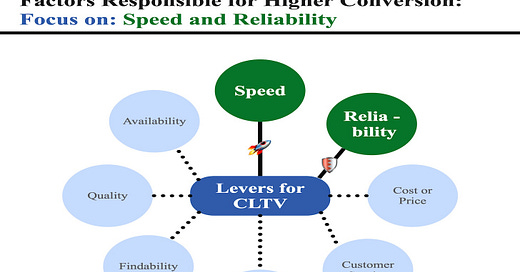🚚 Delivery Speed vs. Reliability: What Customers Actually Care About in Logistics
How Delivery Tradeoffs Impact Conversion Rates, Customer Loyalty, and Logistics Costs
📦 Let’s have a real talk about logistics. 📦
For years, companies have treated logistics like an annoying utility bill—necessary, boring, and mostly something to keep as low as possible.
🔁 But here’s the thing: logistics isn’t just about getting boxes from Point A to Point B. It’s about getting customers from “I might buy” to “I’ll be back, again!.”
💸 Still, most organizations bury logistics under “operations cost” on the balance sheet—and that’s exactly how you end up with late deliveries, higher returns, frustrated customers, and yep, lost revenue.
What Do Customers Actually Want, in 2025?
🕒 Think about the last time you ordered something online.
What mattered to you?
Was it getting it in one day, or
Just knowing when it would show up—and having it actually show up then?
📉 According to McKinsey, ninety percent of customers will ditch their carts if the delivery cost is too high. Same number of folks are fine waiting a bit longer if they can avoid those extra fees.
What would you prefer:
Customers are signaling a clear shift toward valuing reliability—but with limits.
While they prefer on-time delivery over speed, options like 7–14 day shipping are still viewed negatively.
The chart below illustrates how customer preference sharply drops when deliveries become too slow or unpredictable.
Of course, there’s a caveat—the data varies by product category.
Shoppers buying household consumables are less willing to wait beyond three days.
While fashion buyers are generally more flexible with delivery times (generally 4-7 days).
That said, regardless of category, 2025 data shows the top two priorities for online shoppers are:
💵 Low shipping cost and
👁️🗨️ Delivery transparency
Speed ⚡ vs Reliability 🛡️, What’s right for your organization?:
Meanwhile, shipping rates are rising (5.9% increase in 2025 compared to 2024 rates) 📈 —FedEx, UPS, you name it. So while businesses race to keep promises, their margins are melting.
⚖️ And it’s forcing a very real, very uncomfortable question:
Is it worth chasing speed at the cost of reliability?
Faster speed with reliability is the holy grail. When you can deliver quickly and keep your promises, nothing beats it.
That’s exactly why Amazon keeps pulling customers back in—they’ve nailed both. Their secret? An obsessive focus on the customer experience.
But here’s the catch:
If your organization can’t meet high reliability standards, then chasing speed alone turns into a “click and bait” play. Sure, you might win the first sale—but you won’t win trust or loyalty.
And here’s where it gets interesting:
Customer expectations around speed are actually softening. That opens up an opportunity.
If people are okay waiting a bit longer—as long as it’s reliable—you can slow down your supply chain just enough to cut logistics costs and compete more aggressively on price.
🚀 Speed Gets You the Swipe.
🛡️Reliability Gets You the Relationship.
If you’re a growth-stage startup pitching to VCs, speed might be your go-to move.
I get it—conversion rates look great on a pitch deck.
From what I’ve seen, each one-day improvement in delivery speed can boost conversions by 7 to 10 percent, up to about eight days.
So you promise faster delivery to get that first customer in the door.
But what happens after the first sale?
That’s where reliability steps in. A five percent boost in delivery reliability can increase lifetime value by up to seventeen percent. Why? Because customers trust you. They don’t just buy once—they come back.
Speed drives the first purchase. Reliability drives the next five.
NOTE: Speed and Reliability are two of several levers that influence customer lifetime value (LTV); while other factors like product quality, price, and service matter too, this article focuses specifically on how delivery speed and reliability shapes LTV.
💸 The Real Cost of Chasing Speed
Speed sounds great—until you’re staring at a half-empty truck speeding toward a city just to meet a one-day promise. That’s not efficiency, that’s money on wheels… rolling out of your budget. 🛻 💸
Whether you’re using LTL (Less than Truck Load) carriers or running your own fleet, faster delivery often means higher logistics costs.
More miles, fewer packages, more inefficiencies.
Who pays these costs❓
They’re eventually pushed back to retailers—and yes, to customers too.
🎯 But here’s the opportunity:
If customers are already telling us they’re willing to wait a bit longer for reliable service, why not trade a little speed for a lot of savings—and pass those savings back as competitive prices?
🧭 So, What Should You Do?
If you’re a scaling brand, know where you are in the journey.
You might need speed today to drive growth. But don’t ignore reliability—it’s your LTV (Life Time Value) engine.
If you’re more established, lean into reliability.
Customers want clear delivery windows, honest updates, and packages that arrive when you say they will, “do what you say, you are going to do”
🤝 That’s what builds loyalty.
🔄 That’s what reduces refunds and returns.
🏆 That’s what boosts your brand.
🧠 And remember:
You don’t need to match Amazon’s pace.
But you do need to keep your promise.







